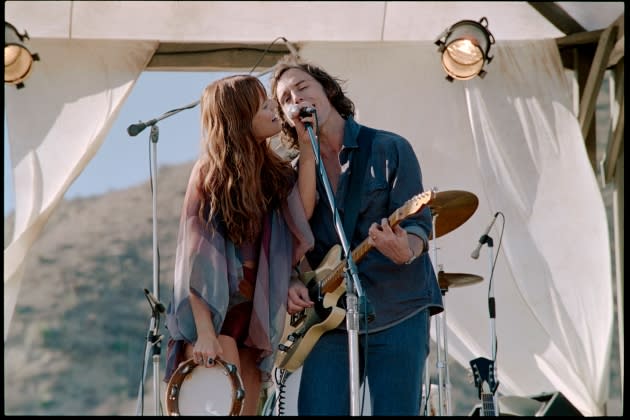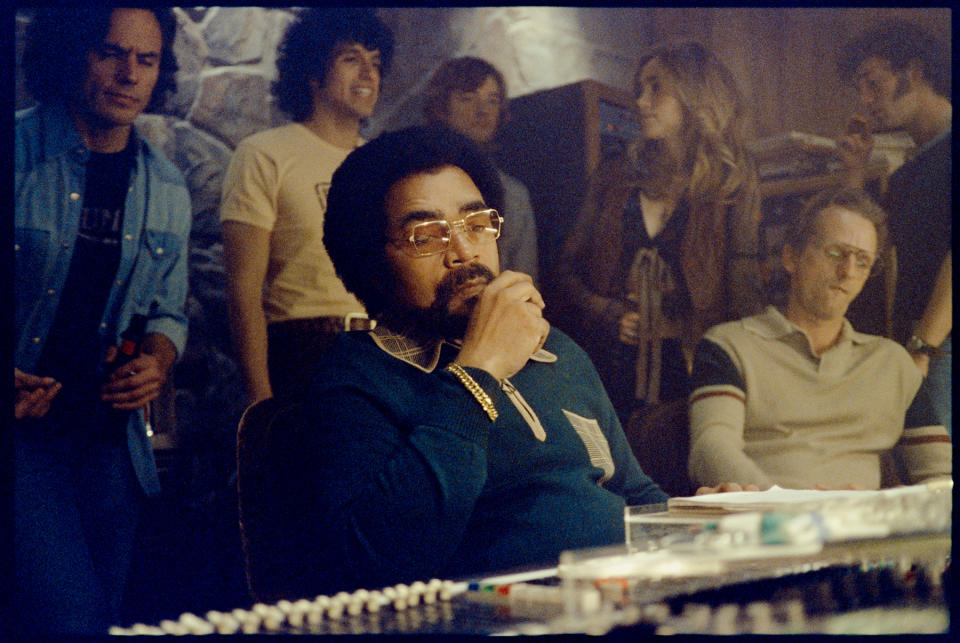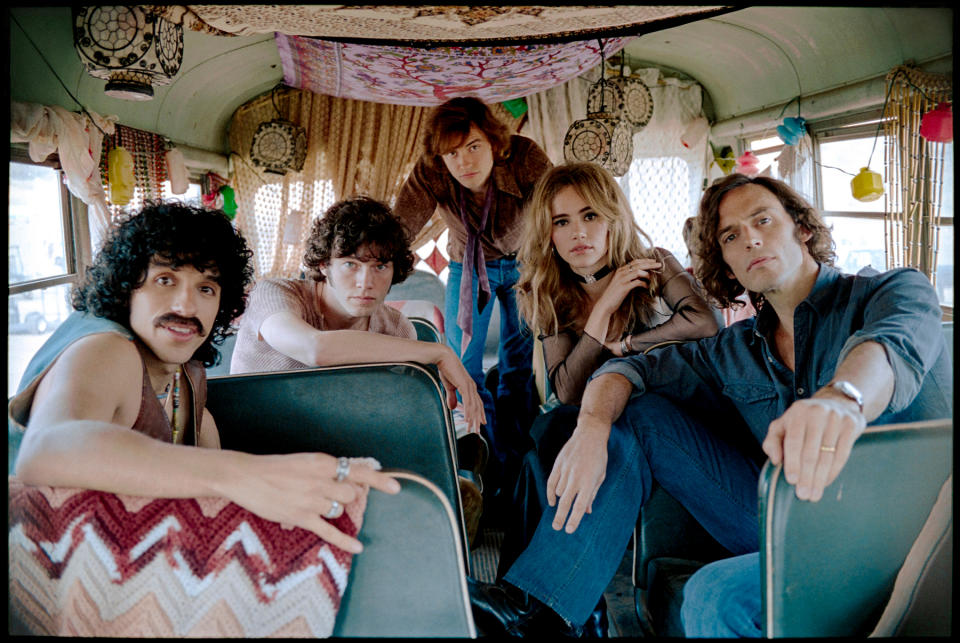‘Daisy Jones & the Six’ Is ‘Almost Famous’ by Way of Fleetwood Mac
- Oops!Something went wrong.Please try again later.
- Oops!Something went wrong.Please try again later.

In Taylor Jenkins Reid’s bestselling novel Daisy Jones & the Six, an oral history of a fictional Seventies rock band that imploded at the height of its fame, we get conflicting accounts of how the band became known as the Six before the troubled Daisy joined as the seventh member. The surviving musicians disagree on specifics, but all concur that it had to do with there being six people in the group at the time.
In Amazon Prime’s adaptation, the pre-Daisy incarnation of the band has one fewer member. The name only arises because a sixth person — Camila (Camila Morrone), wife of frontman Billy (Sam Claflin) — is present during the brainstorm session. Bass player Eddie (Josh Whitehouse) rightly points out that people could find this inconsistency confusing. But drummer Warren (Sebastian Chacon) argues that “the Five” would sound like too many other groups, including the Dave Clark Five and the Jackson 5. So, “the Six” it is.
More from Rolling Stone
Riley Keough and Sam Claflin Unravel on 'Daisy Jones & the Six' Single 'Look At Us Now (Honeycomb)'
Black Women's 'Sex and the City' Is Back to Make Us Feel Seen
'The Last of Us' Is Just the Beginning of Hollywood's Big Video Game Gamble
Like Eddie doing basic arithmetic, audiences may find that it’s hard to look at this TV version of Reid’s story without feeling like something is missing.
The 10-episode miniseries has some excellent performances — particularly by Claflin and by Riley Keough, as Daisy — and other virtues beyond that, as it traces the intertwined lives of the two halves of its title. Daisy grows up in Los Angeles feeling hopelessly alone in the home of her wealthy but unloving parents, and as an adult is used by men, with only closeted disco singer Simone (Nabiyah Be) seeing her as a person. Billy, meanwhile, assembles little brother Graham (Will Harrison) and Graham’s high school classmates Eddie and Warren into a band that he hopes will provide a way to escape Pittsburgh and some dark family memories of their own. After they all — including Karen (Suki Waterhouse), an English keyboard player recruited by a lovestruck Graham — experience various personal and professional travails, legendary record producer Teddy (Tom Wright) has the idea to put Daisy in the group, and magic happens — along with sexual tension, bitter arguments, substance abuse, and the rest of the package.

There are a lot of promising individual components, and some juicy drama. But Daisy Jones & the Six has two fundamental problems it can only occasionally overcome.
The first is that the book’s oral-history format — with Billy, Daisy, and the rest providing differing accounts of the Six’s tumultuous rise and fall — is an irresistible gimmick. We’ve been inundated with real classic-rock oral histories over the years, and in this case, the format makes you constantly question who and what to believe. Was Billy an egomaniacal control freak threatened by Daisy’s arrival, or was Daisy an untrustworthy junkie whose erratic behavior demanded a firmer hand? And even if it’s a bit of both, how much weight should you give any one memory? It’s engaging and unpredictable, and the structure prevents what would otherwise be a very familiar story from falling into pure cliché.
The TV show loses that Rashomon component. There are periodic talking-head interviews from a documentary being produced in 1997, which occasionally pit the recollections of one band alum against another, but all the Sixties and Seventies material is presented as objective truth, like it would be in a drama that lacks any kind of framing sequence. And once you take the ambiguity out of it, then this is a pretty straightforward pastiche of various real and fictional band disputes, with an especially heavy dose of Rumours-era Fleetwood Mac. Daisy even twirls around onstage in a variety of silk scarves like Stevie Nicks, and the penultimate episode opens with “Gold Dust Woman.”
Which brings us to the other core issue. Just as the book invited you to choose your own version of the truth to believe, it allowed you to imagine what the Six sounded like. That’s not an option here. Unlike Stillwater in Almost Famous — a movie set in roughly the same time period, and also featuring the band doing an impromptu singalong (Elton John’s “Tiny Dancer” there, the Faces’ “Ooh La La” here) to diffuse a moment of great tension — we have to believe that the Six were, for a time, the biggest and best band in the entire world. And for that to work, the songs they write and play have to be the equal of the real thing from the mid-to-late Seventies. That is an incredibly tall order — even “That Thing You Do!,” the best fictional-band song of them all, only makes it to Number Seven on the Billboard charts in that film before the one-hit Wonders break up — and the Six’s tunes can’t quite deliver. A few of them are genuinely very good — prepare to have the soaring harmonies of their biggest hits, “Look at Us Now” (from an all-star songwriting team including Blake Mills, Jason Boesal, Stephony Smith, Johnathan Rice, and Marcus Mumford) and “Aurora” (written by Mills, Chris Weisman, Cass McCombs, and Matt Sweeney), stuck in your head for a while after watching. But many others feel purely functionary. And flanked by a soundtrack filled with the genuine article — not to mention episode titles named for real-life tracks like “She’s Gone” and “Feels Like the First Time” — even “Aurora” sounds at best like a Fleetwood Mac deep cut. Claflin and Keough look incredible trading sultry glances while leaning into the same mic (both do their own singing), but they can only do so much to make the illusion of the Six’s genius seem real.

Still, there are those performances. The Daisy on the page is so ethereal and unknowable it seems impossible to imagine any actor making her feel real in live action. 500 Days of Summer screenwriters Scott Neustadter and Michael H. Weber, and their Spectacular Now director James Ponsoldt, wisely don’t ask Keough to try. This Daisy is broken, but still recognizably human and fragile. Keough, whose family history unfortunately has taught her a lot about rock & roll tragedy (she is Elvis Presley’s granddaughter), has a winning gleam in her eye as Daisy begins to clash with Billy, and the magnetism to make Daisy feel plausibly beloved, even if the songs don’t necessarily live up to her. Claflin has the cheekbones and stage presence of a Seventies rock god, as well as the vulnerability necessary to keep Billy from being insufferable as he rides herd on the band and hurts Camila with his drinking and obvious attraction to Daisy. Supporting players like Wright, Waterhouse, and Be also do lovely work playing characters who constantly feel underestimated by the music business.
But it’s not really until the last episode, depicting the band’s final performance at a packed Chicago football stadium, and the soap operatics taking place both onstage and off, that the limited series is able to deliver the level of sad grandeur it keeps promising.
Billy doesn’t want Daisy around because he’s afraid to lose control of both the group and his self-destructive emotions. Teddy, though, sees her as the secret ingredient that can take a midlevel band like the Six and make them superstars. Though the Amazon version of Daisy Jones is very watchable, it also never finds its own equivalent secret ingredient to push it over the top.
The first three episodes of Daisy Jones & The Six will begin streaming on March 3 on Amazon Prime Video, with three more episodes on March 10, two more on March 17, and the last two on March 24. I’ve seen the whole season.
Best of Rolling Stone

